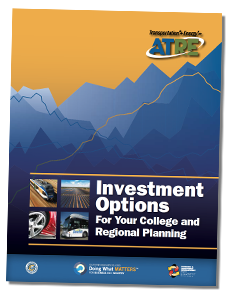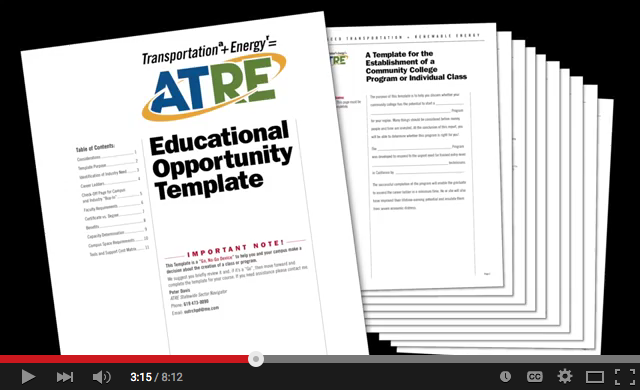Green/Energy Presentations
Resources:
- Intro to Energy (CDE Powerpoint Presentation, D. Esmaili) 56MB, ppt
Links:
- Energy Quest For Kids. (www.energyquest.ca.gov)
Energy Efficiency
Efficient energy use, sometimes simply called energy efficiency, is using less energy to provide the same level of energy service. An example would be insulating a home to use less heating and cooling energy to achieve the same temperature. Another example would be installing fluorescent lights and/or skylights instead of incandescent lights to attain the same level of illumination. Efficient energy use is achieved primarily by means of a more efficient technology or process rather than by changes in individual behaviour.
Energy efficient buildings, industrial processes and transportation could reduce the world’s energy needs in 2050 by one third, and help controlling global emissions of greenhouse gases, according to the International Energy Agency.
Energy efficiency and renewable energy are said to be the “twin pillars” of sustainable energy policy.
Resources:
- HVAC: Energy Management (Energy Eff. Component)
Resources: Commercial Building Energy Analysis and Audits Program
- Complete program (99 Mb)
- Program Overview (pdf)
- ENRG 50: Intro to Commercial Building Audits
- ENRG 51: Microsoft Excel & Word for Energy Audits
- ENRG 52: Energy and Building Science Fundamentals
- ENRG 53: Utility Rates, Benchmarking and Financial Analysis
- ENRG 54: Lighting Systems and Controls
- ENRG 55A: HVAC1 Fundamentals and Components
- ENRG 55B: HVAC2 Systems and Efficiencies
- ENRG 56: Building Envelope Systems
- ENRG 57: Miscellaneous Building Systems
- ENRG 58: Demand Response for Energy Auditors
- ENRG 59: Simulation Methods and Code Compliance
- ENRG 60: Professional Behavior for Energy Auditors
- ENRG 61: Measurement Tools and Verification of Savings Calculations
- ENRG 62: Audit Report Writing
- ENRG 63: Field Experience with Reporting
Links:
- Carbon Footprint Calculator
- U.S. DOE: Energy Efficiency and Renewable Energy (www.eere.energy.gov)
Geothermal Technology
Geothermal power (from the Greek roots geo, meaning earth, and thermos, meaning heat) is energy generated from heat stored in the earth, or the collection of absorbed heat derived from underground. Prince Piero Ginori Conti tested the first geothermal generator on 4 July 1904, at the Larderello dry steam field in Italy. The largest group of geothermal power plants in the world is located at The Geysers, a geothermal field in California, United States. The Philippines and Iceland are the only countries to generate a significant percentage of their electricty from geothermal sources; in both countries 15-20% of power comes from geothermal plants. As of 2008, geothermal power supplies less than 1% of the world’s energy. The most common type of geothermal power plants (binary plants) are closed cycle operations and release essentially no GHG emissions; geothermal power is available 24 hours a day with average availabilities above 90% (compared to about 75% for coal plants).
Links:
- Geothermal Energy in California (CEC)
- Oil, Gas & Geothermal – Dept. of Conservation
- Geothermal Resources Council (www.geothermal.org)
- Geothermal – U.S. Bureau of Land Management
- Caligrafia curso - Escola Britannica
Green Careers
A green-collar worker is a worker who is employed in the environmental sectors of the economy, or in the agricultural sector. Environmental green-collar workers satisfy the demand for green development. Generally, they implement environmentally conscious design, policy, and technology to improve conservation and sustainability. Formal environmental regulations as well as informal social expectations are pushing many firms to seek professionals with expertise with environmental, energy efficiency, and clean renewable energy issues. They often seek to make their output more sustainable, and thus more favorable to public opinion, governmental regulation, and the Earth’s ecology.
Green collar workers include professionals such as conservation movement workers, environmental consultants, environmental or biological systems engineers, green building architects, holistic passive solar building designers, solar energy and wind energy engineers, nuclear engineers, green vehicle engineers, “green business” owners, green vehicle, organic farmers, environmental lawyers, ecology educators, and ecotechnology workers. They also include vocational or trade-level employment: electricians who install solar panels, plumbers who install solar water heaters, and construction workers who build energy-efficient green buildings, wind power farms, or other clean, renewable, sustainable future energy development workers could all be considered green jobs.
There is a growing movement to incorporate social responsibility within the green industries. A sustainable green economy simultaneously values the importance of natural resources and inclusive, equitable, and healthy opportunities for all communities.
Resources:
- Green Jobs Guidebook: Employment Opportunities in the New Clean Economy PDF (3.8MB)
- Green Jobs and the California Community Colleges (Feb. 09) PPT (1.1MB)
Links for Green Careers and Labor Market Data:
- Technical Support to the California Green Jobs Council
- Occupational Information Network (O*Net)
- California’s Green Economy Report
- National Solar Jobs Census 2010
Wind Energy
Wind power is the conversion of wind energy into a useful form, such as electricity, using wind turbines. At the end of 2007, worldwide nameplate capacity of wind-powered generators was 94.1 gigawatts. Although wind produces only about 1% of world-wide electricity use, it is growing rapidly, increasing more than fivefold globally between 2000 and 2007. In several countries it has achieved relatively high levels of penetration, accounting for approximately 19% of electricity production in Denmark, 9% in Spain and Portugal, and 6% in Germany and the Republic of Ireland in 2007.
Resources:
- Heavy Wind-Generation Technician Training Curriculum Outline
Resources: Wind Tech
NOTE: All Quizzes, Answers and Class Summary/Final require password for access. Contact Peter Davis at outrchpd@me.com for information on access.
- Wind Tech Curriculum Outline PDF
- Wind Tech Powerpoint PDF – All Sections, 793 pages, 48 Mb.
- Series 100 – Intro to Wind, OSHA Safety, .zip archive
- Series 100 – Quiz and Answers
- Series 120 – First Aid & CPR, Tower Rescue, Safety in the Wind Park, .zip archive
- Series 120 – Quiz and Answers
- Series 130 – Electrical Measurement Safety, Multimeters, Amp Clamps, Voltage pens, Megohmeters, Infrared Testers, O Scopes, .zip archive
- Series 130 – Quiz and Answers
- Series 140 – Schematics, DC Theory, .zip archive
- Series 140 – Quiz and Answer
- Series 150 – AC Theory, .zip archive
- Series 150 – Quiz and Answers
- Series 160 – 50 Volts and Higher Safety, Electrostatic Discharge, Compressed Gas, Hydraulics, .zip archive
- Series 160 – Quiz and Answers
- Series 170 – Concepts of Electronics, Fiber optics, Soldering, .zip archive
- Series 170 – Quiz and Answers
- Series 180 – Wind Turbine Mechanical Systems, Torquing & Fasteners, Wind Turbine Electrical Systems, .zip archive
- Series 180 – Quiz and Answers
- Series 190 – PLC’s & Control Algorithims, Substations & Transformers, .zip archive
- Series 190 – Quiz and Answers
- Series 200 – Maintenance Practices, Troubleshooting, Service reporting, .zip archive
- Series 200 – Quiz and Answers
- Series 210 – Rotor Construction & Airfoils, Fiber Glass Repair, Blade Pitch & Balancing, .zip archive
- Series 210 – Quiz and Answers
- Series 220 – SCADA & Data Analysis, Meteorology, Power Curves, .zip archive
- Series 220 – Quiz and Answers
- Series 230 – Class Summary and Final, .zip archive. Contact Peter Davis at outrchpd@me.com for information on access.
Links:
- CEC: Wind Energy Generation
- AWEA
- Power of Wind
- Illustrated History of Wind Power
- NABCEP: Small Wind Exam Resouce Guide (PDF)
- Oregonian – Wind Power in NW PDF (1.5MB)
- GE Turbine Installation Video National Renewable Energy Laboratory (NREL)
- American Wind Energy Collaborative (AWEA) YouTube Channel
Solar and Photovoltaic Energy
Solar power technologies provide electrical generation by means of heat engines or photovoltaics. Once converted its uses are only limited by human ingenuity. A partial list of solar applications includes space heating and cooling through solar architecture, potable water via distillation and disinfection, daylighting, hot water, thermal energy for cooking, and high temperature process heat for industrial purposes.
Solar technologies are broadly characterized as either passive solar or active solar depending on the way they capture, convert and distribute sunlight. Active solar techniques include the use of photovoltaic panels, solar thermal collectors, with electrical or mechanical equipment, to convert sunlight into useful outputs. Passive solar techniques include orienting a building to the Sun, selecting materials with favorable thermal mass or light dispersing properties, and designing spaces that naturally circulate air.
Resources:
- Solar Theory
- Solar Energy Lab
- Solar: System Plumbing
- Advanced Plumbing (Solar Component)
- Photovoltaic Installation, Entry Level
- Utility-Scale Solar Energy Curriculum
Links:
- Creating a Brighter Future for Humanity Through Solar Energy – pdf (1MB)
- Commercial Market Development (Solar Conference 2006) – pdf (1.3MB)
- Energy Efficiency, Solar Energy and Climate Change – pdf (2.2MB)
- Integrating PV with EE for Large Scale Projects – pdf (1.1MB)
- California Solar Initiative Overview – pdf (65Kb)
- Solar on Track for PBI Net Metering & Backup Power – pdf (1.6MB)
- Solution to Silicon Shortage in the Global PV Market – pdf (1.7MB)
- The Regulatory Environment for Solar: California Solar Initiative (CSI) – pdf (272Kb)
- The Mechanics of the RECs Market – pdf (6.3MB)
- Solar Energy Technology Update: Current Perf & Future Tech Trends – pdf (1.8MB)
- San Diego Unified School District Photovoltaic System Presentation – pdf (1.2MB)
- Hybrid Solar Lighting Slideshow – pdf (232kB)
- Solar in New Home Construction ZENH and Multifamily Affordable Housing – pdf (109 kB)
- A Bright Future: Solar Energy Legislation – pdf (354kB)
- Solar Schools Program: California Energy Commission – pdf (4.8MB)
- Distributed Generation Solutions for Wineries and Vineyards – pdf (1.4MB)
- SunPower: San Diego Solar Conference 2006 – pdf (1.1MB)
- Solar 101 – “Not All Watts are Created Equal” – pdf (722kB)
- Leveling the Playing Field to Properly Value Solar – pdf (611kB)
- Solar Technician Training (Energy Engineers) – Silicon Valley Solar IDRC
- California Energy Solutions YouTube Channel – iTunes Includes Global Warming Discussion (5-part) and Solar Energy Industry Discussion (3-part).
- National American Board of Energy Practitioners (NABCEP)
- Institute for Sustainable Power (ISP)
- Solar Energy Industry Association (SEIA)
- California Solar Initiative
- Stirling Energy Systems Unveils Commercial Scale Plant. (Renewable Energy World.com) We get a first look at Stirling Energy Systems’ Maricopa Solar plant in Arizona and hear from Tessera Solar CEO Bob Lukefahr about the companies’ plans for future developments.
- Up Close and Personal with Stirling Energy’s CSP. Just outside Phoenix, Arizona sits a field of dishes reflecting the hot desert sun.
Energy Efficiency
Efficient energy use, sometimes simply called energy efficiency, is using less energy to provide the same level of energy service. An example would be insulating a home to use less heating and cooling energy to achieve the same temperature. Another example would be installing fluorescent lights and/or skylights instead of incandescent lights to attain the same level of illumination. Efficient energy use is achieved primarily by means of a more efficient technology or process rather than by changes in individual behaviour.
Energy efficient buildings, industrial processes and transportation could reduce the world’s energy needs in 2050 by one third, and help controlling global emissions of greenhouse gases, according to the International Energy Agency.
Energy efficiency and renewable energy are said to be the “twin pillars” of sustainable energy policy.
Links:
- Carbon Footprint Calculator
- U.S. DOE: Energy Efficiency and Renewable Energy
Energy Groups/Agencies
- Union of Concerned Scientists (www.ucsusa.org)
- Natural Resources Defense Council (www.nrdc.org)
- Communities for a Better Environment (www.cbecal.org)
- Environment California (www.environmentcalifornia.org)
- United States Environmental Protection Agency (www.epa.gov)
- United States Department of Energy (www.doe.gov)
- United States Department of Agriculture (www.usda.gov)
- California Environmental Protection Agency (www.calepa.ca.gov)
- California Air Resources Board (www.arb.ca.gov)
- California Energy Commission (www.energy.ca.gov)
- California Department of Food and Agriculture (www.cdfa.ca.gov)
- South Coast Air Quality Management District (www.aqmd.gov)
- California Center for Sustainable Energy (http://energycenter.org)










